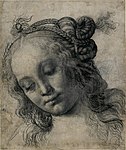Portrait of a Young Woman (Botticelli, Frankfurt)
| Portrait of a Young Woman | |
|---|---|
 | |
| Artist | Sandro Botticelli |
| Year | 1480–1485 |
| Medium | Tempera on wood |
| Dimensions | 82 cm × 54 cm (32 in × 21 in) |
| Location | Städel Museum |
Portrait of a Young Woman is a painting which is commonly believed to be by the Italian Renaissance painter Sandro Botticelli, executed between 1480 and 1485. Others attribute authorship to Jacopo da Sellaio. The woman is shown in profile but with her bust turned in three-quarter view to reveal a cameo medallion she is wearing around her neck. The medallion is a copy in reverse of "Nero's Seal", a famous antique carnelian representing Apollo and Marsyas, which belonged to Lorenzo de' Medici.[1][2][3]
It is housed in the Städel Museum of Frankfurt, Germany. Other similar Botticelli paintings are to be found in the National Gallery, London, the Gemäldegalerie, Berlin, and in the , Tokyo.[4]
The art historian Aby Warburg first suggested the painting was an idealised portrait of Simonetta Vespucci.
This challenged a previous interpretation, put forward by German scholars, according to which the painting describes an ideally beautiful young woman mythologised as a nymph or goddess, a view reflected in the title given it by the Städel. It belongs to a group of such paintings by Botticelli or his workshop.[4] Art historian Emanuele Lugli has suggested that the three "tassels" of hair at the center of the painting represents downward flames, symbolising the love that onlookers ought to experience when looking at the portrait since, in the Renaissance it was thought that "hair inflames desire."[5]
Gallery[]

Andrea del Verrocchio - Head of a Woman, (verso & recto), c. 1475, charcoal (some oiled?), heightened with lead white, pen and brown ink (r.), charcoal (v.), 324 x 273 mm., British Museum. Verrocchio is credited with inventing this type of ideal beauty.[2][6]

Seal of Nero, a carnelian engraved gem dating from the time of Augustus once in the possession of Lorenzo de’ Medici, currently in the Naples National Archeological Museum
Sources[]
- References
- ^ Malaguzzi 2004, p. 73.
- ^ a b Brown 2001, p. 182.
- ^ Gibson, This write life Archived 15 September 2013 at WebCite
- ^ a b Brown 2001, p. 184.
- ^ Lugli, Emanuele (2019). "The Hair is Full of Snares: Botticelli's and Boccaccio's Wayward Erotic Gaze". Mitteilungen des Kunsthistorischen Institutes in Florenz. 61 (2): 224–25, 203–233.
- ^ Wivel 2010.
- Bibliography
- Brown, David (2001). Virtue & beauty : Leonardo's Ginevra de' Benci and Renaissance portraits of women. Washington: National Gallery of Art. ISBN 978-0-691-11456-9. OCLC 46314886.
- Gibson, Mary Jo. "What was really in the Medici Treasury?". This Write Life. Archived from the original on 15 September 2013. Retrieved 15 September 2013.
- Malaguzzi, Silvia (2004). Botticelli. Florence: Giunti. ISBN 88-09-03677-8. OCLC 55698818.
- Musa, Mark (1999). Petrarch: The Canzoniere. Indiana University Press. ISBN 978-0-253-21317-4.
- Quint, David L. (2005). The Stanze of Angelo Poliziano. Penn State University Press. ISBN 978-0-271-02871-2.
- Wivel, Matthias (2010). "Traces of Soul, Mind, and Body". The Metabunker. Archived from the original on 15 September 2013. Retrieved 15 September 2013.
External links[]
| Wikimedia Commons has media related to Portrait of a Lady, Simonetta Vespucci as a Nymph (Botticelli). |
- 15th-century portraits
- 1480s paintings
- Portraits by Sandro Botticelli
- Paintings in the collection of the Städel
- Portraits of women


